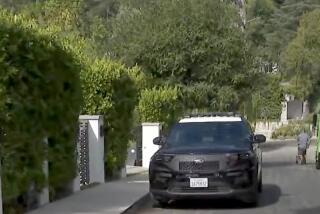Another instance of #livingwhileblack? Ving Rhames recalls 2016 police incident at his Santa Monica home
Ving Rhames was sitting in his Santa Monica home watching ESPN, when he heard a knock at his door.
The “Mission: Impossible Fallout” star, wearing only basketball shorts, answered the knock, only to be greeted by a Santa Monica police officer’s gun. A neighbor, they said, had called 911 to report that a “large black man” was burglarizing the property.
Rhames recalled the July 29, 2016, incident Friday on “The Clay Cane Show” on Sirius XM.
“They apologized,” the 59-year-old African American actor told the host, adding that one of the responding officers recognized him because their children played sports together.
This was not the first such incident in the coastal city of about 92,000 people, where, according to 2016 census estimates, the population is 65% white and about 4% black.
In November 2015, a black woman named Fay Wells wrote an article in the Washington Post about being confronted by nearly 20 police officers at her Santa Monica apartment after a neighbor thought she was breaking in.
Recently, racial incidents in which police are called on black people involved in innocuous activities have gained notoriety nationally, leading to the meme #livingwhileblack. In May, a black woman was leaving an Airbnb in Rialto when a person called police, and a week earlier, a woman who fell asleep in her dorm’s common area was awakened by a white student who said she shouldn’t be there and called police.
The month before, two African American men in Philadelphia waiting for a friend at Starbucks were arrested on suspicion of trespassing.
In June, several people involved in those incidents asked Congress to hold a hearing on racial profiling, saying that the nation’s attention has been “riveted” by headline after headline of “law-abiding citizens finding their actions misperceived, being racially profiled and having police called for engaging in everyday activities.”
In Santa Monica, the department established a Meet Your Neighbors program in 2017, challenging neighborhoods to hold meet-and-greets with their fellow residents. The department then entered the neighborhoods into a raffle for a free block party.
“It’s based off the need of the community,” Lt. Saul Rodriguez, a spokesman for the department, said of the program.
Rodriguez said it’s difficult to know whether similar incidents have transpired in the last two years because the department doesn’t track such calls.
Reinhard Kargl, chairman of a neighborhood coalition where the incident involving Rhames took place, said there have been several recent violent break-ins in the area. Kargl said that “there’s a lot of pressure” on the Police Department to “respond aggressively.”
“I see both sides,” said Kargl, who has lived in Santa Monica for nearly 30 years. “It’s a very tricky situation to handle.”
Rodriguez said that Rhames never made a formal complaint. He confirmed that police received a call of a break-in in which the suspect was thought to be a black man. Rodriguez couldn’t say whether police drew weapons on Rhames but said it wouldn’t be unusual in a circumstance where a suspected burglar is confronted.
“It was an appropriate response,” he said.
Policing experts, however, said there are steps to prevent such encounters, even when residents give inaccurate information to responding officers.
“They could have simply determined who lived at the address and whether they fit the description,” said Merrick Bobb, executive director of Police Assessment Resource Center who for years was a civilian monitor of the Los Angeles County Sheriff’s Department. In this case, Bobb said, upon arriving at the scene, officers could have spoken with the caller for a more accurate suspect description.
Bobb said that when an officer points a weapon it is considered a use of force that is reportable, and should have been recorded by the department.
“That officer needs to be able to show probable cause for drawing the weapon,” he said. “They need to be able to explain their actions.”
Rodriguez said officers did not run a check on who owned the property or lived there before approaching the home, but were acting on information in the 911 call that the person inside “did not live there and the owners were out of town.”
Rodriguez said the department does not have a record of whether an officer drew a gun and pointed it because it is not department protocol or policy to document such an incident.
In the radio interview, Rhames said that after the confrontation, he and the officers spoke to neighbors, who denied making the report.
“My problem is ... what if it was my son and he had a video game remote or something and you thought it was a gun?”
Twitter: @lacrimes
More to Read
Sign up for Essential California
The most important California stories and recommendations in your inbox every morning.
You may occasionally receive promotional content from the Los Angeles Times.












